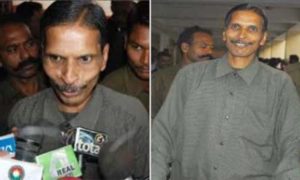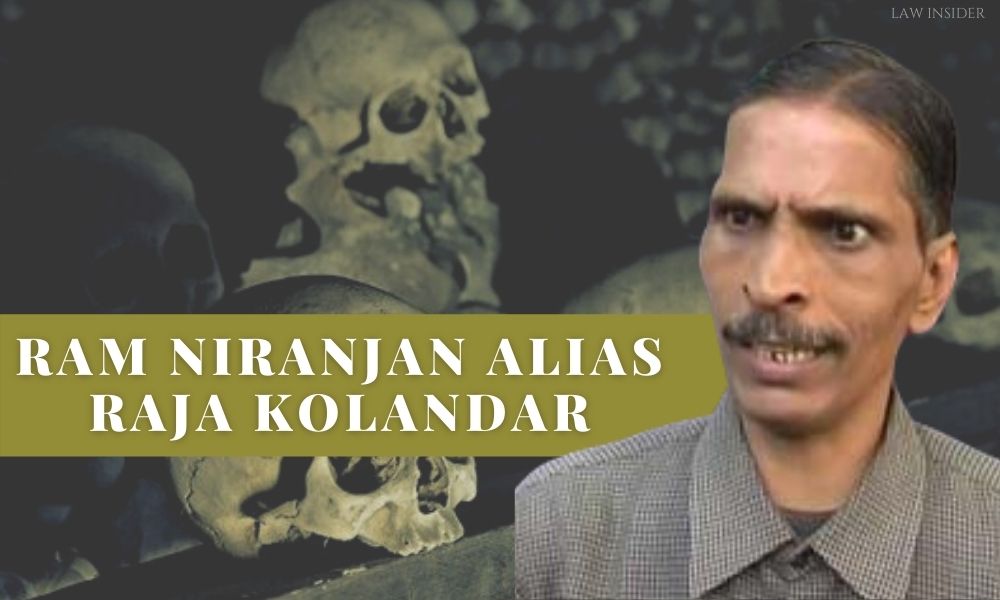By RAMYATA DASS
INTRODUCTION
Behind the veil of an innocent name Ram Niranjan was sheltering UP’s first reported cannibal Raja Kolandar. He is a person known to have allegedly killed 14 people to savour their ‘brains’ which afterwards he boiled and drank as soup.
The notorious killer came into the limelight for the murder of Dhirendra singh, a reporter for a Hindi daily. Before going deep into the unsettling endeavours of Raja Kolandar here is a brief background of him.

Name: Ram Niranjan alias Raja Kolandar
Age: 50
Location: Allahabad, Uttar Pradesh
Job: Worker at Ordinance Factory
Alliance: Vaksharaj (Brother-in-law)
Main victim: Dhirendra Singh
Mode of Killing: Gun shot
Marital status: Married
Wife’s Name: Phoolan Devi
Offsprings: 2 sons namely Adalat and Jamanat
BACKGROUND
Ram Niranjan was a 50 year old man when in the year 2000 on December 18th he was taken into custody for the suspected murder of a reporter of a Hindi daily named Dhirendra Singh.
The reporter had gone missing, due to which his family member filed an FIR at the Kydganj police station on the 17th of December, 2000. As part of investigation the police had scanned Dhirendra’s call records which revealed that a call was made to one Phoolan Devi on 16th December 2000.
The police initially took Phoolan in custody and during the course of interrogation she narrated the truth about Kolandar.
MURDERS
In criminal law for a person to be held guilty of an offence there are two components to be fulfilled i.e. Mens rea and Actus reus which is the criminal intention coupled with the act. For Raja Kolandar, mostly the reason for killing people was over petty issues.
The police investigation uncovered the murder not just of Dhirendra but of 14 other people. Raja kolandar had a pattern in his murders. He would dismember the victim’s body and throw the body parts in different places like lakes, rivers and forests away from the place of murder.
Although one thing was common in most of the cases i.e. he kept the head of the victims to eat their brain. He had a twisted psychology where he would hang their skulls as a trophy in his own house. Sometimes he also used to throw the body parts to the pigs at his farm house too.[1]

INVESTIGATION
The police had taken Phoolan devi in custody who narrated the truth about his husband, Raja Kolandar. During further probe it was found that Raja had an alliance who was his brother in law named Vaksharaj. Later, Kolandar and Vaksharaj were arrested and a stolen vehicle (tata sumo) was recovered from them.
He confessed to the police that he with the help of Vaksharaj, had killed Dhirendra on 17th December, 2000. He told the police that he had called Dhirendra at a farmhouse in Pipri, Sonbhadra district, UP where Vaksharaj shot him dead. They loaded the body in the victim’s vehicle, dumped the body and the head at a place on the Allahabad-Rewa road.
His wife Phoolan Devi was a member of the district panchayat and the reason for Dhirendra’s killing was cited due to the rivalry during panchayat polls in which she had emerged victorious. On rummaging Kolandar’s house there were 14 human skulls recovered.
The incident had a drastic effect across the state. It was unveiled that Kolandar’s first victim was a colleague at the ordinance factory. This took place in the year 1998. The police testimony according to sources[2] reveals that he had killed his colleague to eat his brain because he belonged to a community which was believed to have sharp brains. He had also confessed that he killed three people in a taxi before.
The reason was that they had refused to give him lift from Allahabad to Lucknow. Such instances answer to his nature of killing people over petty issues. The police said that he considered himself as a king and a Judge. He used to segregate his victims’s skulls on the basis of their castes and used to give judgement on them.
The police had also recovered a diary belonging to Kolandar, which he used to call the court diary. This diary had details about his victims and also about those he wanted to kill.[3] He had also named two of his sons as Adalat (court) and Jamanat (Bail).
When Kolandar confessed the whereabouts of Dhirendra’s body the police went looking for it. Dismembered body parts of Dhirendra were recovered from the lake at Rewa in Madhya Pradesh. He further confessed that he was afraid that Dhirendra would publish reports against him because of which he shot him dead.

COURT’S VERDICT
A chargesheet was filed aganst Kolandar in February 2001. It was only 11 years after, in 2012 that the additional sessions Judge of Allahabad, Mehtab Ahmad found Ram Niranjan alias Raja Kolandar guilty along with his brother-in-law Vaksharaj for the murder of reporter Dhirendra Singh.
The reason for such delay was the difficulty in finding witnesses. Kolandar and Vaksharaj are in jail since their arrest in December 2000. The Court awarded both the perpetrators with life imprisonment. Along with that, the judge had also tagged a fined of Rs, 10,000 each on accused, three years of rigorous imprisonment under section 201[4] of IPC which is punishment for causing disappearance of evidence of offence, or giving false information to screen offender and also an additional fine of Rs 5000 each.
The Judge had sentenced them to an additional one year of rigorous imprisonment under section 404[5] of IPC along with a fine of Rs 1000 each.
INGREDIENTS FOR RAREST OF RARE CASE
It was noted that the prosecution had failed to establish any connection with the 14 other murders and the allegation of cannibalism. The Court was therefore not inclined to treat the case as ‘rarest of rare’. Thereby it is important to look into what constitutes as a Rarest of Rare case.
The case of Bacchan Singh v. State of Punjab AIR 1980 SC 898[6] in the year 1980, laid the doctrine of ‘Rarest of rare’ case was enumerated. The Supreme Court by a majority of 4:1 upheld that capital punishment is maintainable but must be restricted to the rarest of rare cases albeit the ingredients and extent of the same were not made clear.
It was after three years of Bacchan singh, in 1983 in the case of Machhi Singh v. State of Punjab 1983 AIR 957[7] the Supreme Court set down rules for surveying when a case can be regarded as rarest of rare.
- THE MANNER OF COMMISSION OF MURDER– It is extremely brutal, grotesque, diabolical, revolting, or dastardly manner so as to arouse intense and extreme indignation of the community. For instance,
- When the house of the victim is set aflame with the end in view to roast him alive in the house.
- When the victim is subjected to inhuman acts of torture or cruelty in order to bring about his or her death.
- When the body of the victim is cut into pieces or his body is dismembered in a fiendish manner.
2.THE MOTIVE FOR COMMISSION OF MURDER– When the murder is committed for a motive which evinces total depravity and meanness. For instance when-
- A hired assassin commits murder for the sake of money or reward.
- A cold blooded murder is committed with a deliberate design in order to inherit property or to gain control over property of a ward or a person under the control of the murderer or vis-a-vis whom the murderer is in a dominating position or in a position of trust.
- a murder is committed in the course for betrayal of the motherland.
3. SOCIALLY ABHORRENT NATURE OF THE CRIME– When murder of a Scheduled Caste or minority community etc., is committed not for personal reasons but in circumstances which arouse social wrath.
4. In cases of ‘bride burning’ and what are known as ‘dowry deaths’ or when murder is committed in order to remarry for the sake of extracting dowry once again or to marry another woman on account of infatuation.
5.MAGNITUDE OF CRIME– When the crime is enormous in proportion. For instance when multiple murders say of all or almost all the members of a family or a large number of persons of a particular caste, community, or locality, are committed.
6.PERSONALITY OF VICTIM OF MURDER-
- When the victim is an innocent child who could not have or has not provided even an excuse, much less a provocation, for murder.
- A helpless woman or a person rendered helpless by old age or infirmity.
- When the victim is a person vis-a vis whom the murderer is in a position of domination or trust.
- When the victim is a public figure generally loved and respected by the community.
The Court further went ahead and explained that in order to apply these guidelines inter-alia the following questions may be asked and answered:
- Is there something uncommon about the crime which renders sentence of imprisonment for life inadequate and calls for a death sentence?
- Are the circumstances of the crime such that there is no alternative but to impose death sentence even after according maximum weightage to the mitigating circumstances which speak in favour of the offender ?
CASES WHERE DEATH PENALTY WAS AWARDED BY THE COURT
- Bhaeru Singh v. State of Rajasthan, (1994) 2 SCC 407. In this case a person who suspected fidelity of his wife severed her head and killed her. The Supreme Court had no doubt in categorising it as the rarest of rare case and the person was sentenced to death punishment.
- Laxman Naik v. State of Orissa, (1994) 3 SCC 381. A case where a calculated, cold blooded brutally gruesome murder of a girl of very tender age after committing rape on her was undoubtedly a rarest of rare case according to the court.
- Kehar Singh & Ors vs State (Delhi Admn.) 1988 AIR 1883[8] where It was a gruesome murder committed by the accused who was employed as a security guard to protect the Prime Minister Indira Gandhi. It was regarded as one of the rarest of rare a case in which extreme penalty of death is called for.
CONCLUSION
The rules to regard a case as rarest of rare are not strict but are subject to different interpretation. There has been difference in awarding sentence under thus criterion.
In the Present case of Raja Kolandar, since the prosecution was not able to establish the strongest connection to the other 14 murders the court had awarded Kolandar and his alliance Vaksharaj to life imprisonment rather than death punishment.
Reference-
- business-standard.com↑
- timesofindia.indiatimes.com ↑
- indiatvnews.com ↑
- indiankanoon.org ↑
- indiankanoon.org ↑
- indiankanoon.org↑
- indiankanoon.org ↑
- lawinsider.in ↑

